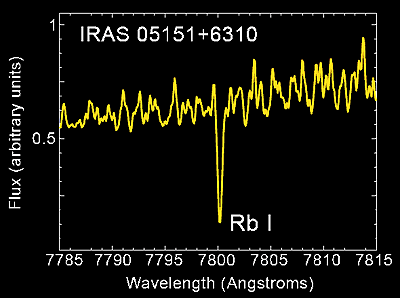A long debated issue concerning the nucleosynthesis of neutron-rich elements in Asymptotic Giant Branch (AGB) stars is the identification of the neutron source.
Low- and intermediate-mass stars (1 to 8 solar masses) evolve toward the asymptotic giant branch (AGB) phase after the completion of hydrogen and helium burning in their cores, before they form planetary nebulae, ending their lives as white dwarfs.
Basically, an AGB star is composed of an inert carbon-oxygen (C-O) core surrounded by a He-rich intershell and an extended H-rich convective envelope. Nuclear energy release is dominated by the H shell and interrupted periodically by thermonuclear runaway
He-shell "thermal pulses" that initiate a series of convective and other mixing events. Strong mass loss enriches the interstellar medium (ISM) with the products of the resulting complex nucleosynthesis. During this thermally pulsing AGB (TP-AGB) phase,
stars originally born O-rich (reflecting the ISM composition) can turn C-rich (C/O > 1) as a consequence of the "dredge-up" of processed material from the bottom of the convective envelope to the stellar surface.
Mixing of protons into the He-rich intershell during the TP-AGB phase leads to reaction chains producing free neutrons, which allow production of neutron-rich elements such as Rb, Sr, Y, Zr, Ba, La, Nd, and Tc by slow neutron capture on iron nuclei and
other heavy elements (the s process).
There are two possible chains for the neutron production: 13C(α,n)16O and 22Ne(αn)25Mg. The 13C neutron source operates at relatively low neutron densities and temperatures in TP-AGB stars
during the interpulse period. The 22Ne neutron source operates at much higher neutron densities and requires higher temperatures, which are achieved only while the convective thermal pulse is ongoing. In the more massive AGB stars where these high temperatures are more easily achieved, the s-process elements are expected to
form mainly through the 22Ne reaction that also strongly favors the production of the stable isotope 87Rb because of the operation of a branching in the s-process path at 85Kr that modifies the isotopic mix between 85Rb and 87Rb.
Unfortunately, the Rb isotope ratio cannot be measured in stellar sources even with the help of very-high-resolution spectra because the lines are too broad, and thus it is difficult to use this parameter as a neutron density indicator.
As an alternative, the total Rb abundance can be used. The theoretical prediction is that the relative abundance of Rb to other nearby elements produced by the s-process, such as Zr, Y, and Sr, is a powerful indicator of the neutron density at the
s-process site and, as such, is a good discriminant of the operation of the 13C versus the 22Ne neutron source in AGB stars.
A team of astronomers using the Utrecht Echelle Spectrograph (UES) on the WHT reported for the first time intermediate-mass (4 to 8 solar masses) AGB stars in our
Galaxy that are rubidium-rich as a result of overproduction of the long-lived radioactive isotope 87Rb.
This represents a direct observational evidence, predicted theoretically 40 years ago, that the slow-neutron capture process following the 22Ne(α,n)25Mg reaction must be the
dominant neutron source in these stars.
Because huge amounts of rubidium-rich processed material can be transferred to the interestellar medium by massive AGB stars, this result has also relevant implications for the rubidium primeval
solar nebula abundance.
Radioactive dating studies of primitive chondrites assume that the initial conditions are known and that the oldest components of chondrites evolved without external
exchange of rubidium but this research suggests that the initial abundance may has been altered by a nearby population of massive AGB stars during the early evolution of our Solar System, and
consequently, the rubidium abundance measured in primitive meteorites should be considered only as a qualitative measure of antiquity.
 |
Figure 1. Rubidium line at 7800 angstroms as detected by UES spectrograph on the William Herschel Telescope in BW Cam, one of observed AGB stars in this study. Credit: IAC/ESA. [ JPEG | TIFF ].
|
References:



